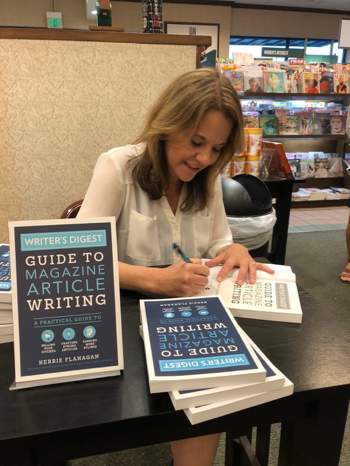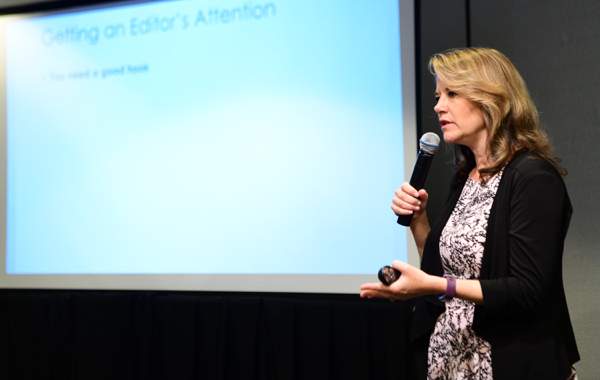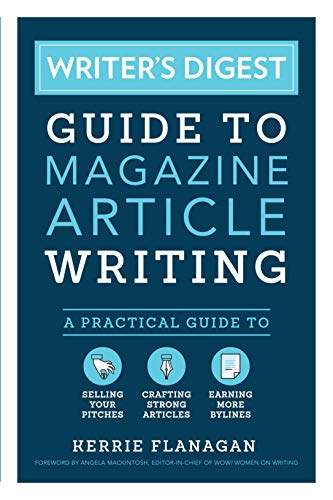Can you boost your author platform by writing for magazines?
I’ve had the pleasure of knowing Kerrie for years, and was honored when she asked me to contribute to her book, “Writer’s Digest Guide to Magazine Writing.” Here, Kerrie generously shares her story of how she got started writing for magazines, and shows you how you can use this skill to boost your author platform.
by Kerrie Flanagan
I am not one of those people who knew from childhood that writing was the profession for me.
I liked writing and English classes throughout school, I even loved diagramming sentences, but I never fantasized about being a writer.
I always wanted to be a teacher (which I was for 10 years). The door to writing cracked open while I was teaching a class of second graders.
How Teaching Led Me to Writing
My task was to teach them how to use a comma in a list. I wanted to find a creative way to get the point across to them, so I wrote a story, made some simple cut out illustrations to go with it and brought it to class to read to them.
Cornelius Comma Saves the Day was a big hit with the kids. I thought it would be helpful to other teachers, so I researched how to publish a book and began sending it out. During this time, I also joined a critique group.
Because this writing world was so new to me, I figured I could use all the help and support I could get. The group had writers of different genres: children’s, romance, historical fiction, personal essays and magazines.
How I Got Started Writing for Magazines
I couldn’t get any interest for my book and ended up finding an illustrator and self-publishing it.
We sold a couple thousand copies and eventually we moved on to other ventures. While all this was going on, I became intrigued by the idea of writing for magazines.
One woman in my writer’s group frequently brought in articles for us to critique. I loved the timeframe of it all; send out a query, get the assignment, write the article and see it in print.
This whole process seemed to take 4-6 months. It was much faster than the book world. Plus, I could fit it more easily into my life which now included a full-time teaching job, a husband and three kids.
How Writing for “Better Homes and Gardens” Opened Some Doors
After learning all I could and doing extensive research, I started querying.
My first published piece ended up in Better Homes & Gardens. It was a craft idea with only about 150 words of text, but it showed me that I could submit ideas and queries to any publication and have a good chance of getting a yes, if I did my research, studied the magazine and only send it to those that were a good fit.
I never did publish another craft idea or article in Better Homes and Gardens, but it did open the door for me to write for other magazines. Not long after, I received an assignment to write a feature article about Colorado wineries for a regional publication.
I eventually resigned from teaching to be more available to my family and to pursue writing. Over the past two decades, I have published hundreds of articles for national, regional, local and niche trade magazines.
There is No Reason to Write for Magazines for Free
I am a firm believer in getting paid for your writing, especially when it comes to magazines.
There is no reason to start out writing for free in order to build up your published clips.
If you take the time to research the magazine (their readers, the types of stories…) pitch them ideas relevant to their readers, and follow their submissions guidelines, you can get an assignment, even if you haven’t published an article before.
Editors are looking for writers who understand their publication and who pitch ideas for articles their readers will enjoy.
You may not be getting paid thousands for your first articles, but you should get compensated.

Writing for Magazines: Send Out More Queries!
Over the past 20+years I’ve been freelancing, I’ve only written articles for free a handful of times. It is a numbers game. The more queries you send out, the higher the potential is for you to get assignments. It really is that simple.
Plus, the more queries you send out, the more practice you get writing them and chances are you will get more positive responses.
After a few years of publishing articles, I began teaching classes on magazine writing. I realized how much I enjoyed working with writers and helping them navigate the writing world.
My love for helping eventually led to me started a writing conference and then a fee-based writing organization. As the years went on, I added consulting and developmental editing services to my offerings for writers.
Writing for Magazines is a Great Way to Grow Your Audience
Many authors think the only way to build a platform and market their books is through social media. But that is far from the truth.
The key to selling books is to connect with readers and build a community. Social media is one way to do this, but it’s not the only way to promote your work.
Magazine articles are also an effective way to grow your audience for both fiction and nonfiction authors. Writers may be able to reach a couple thousand people with a Facebook post, but one article has the potential to reach tens of thousands of readers.
Plus, you get to spend time writing and get paid for it (if you choose the right markets). It’s definitely a win-win situation.
Magazine articles allow you a genuine way to connect with many potential readers. Your words provide information, encouragement, or entertainment. If your article resonates with readers, a short bio at the end such as “Janice Stephen is the author of The World’s Best Novel” might encourage them to look you up and learn more about you and your book.
The article also gives you something to highlight on your website and on social media. For nonfiction authors, an article related to your book’s topic is the perfect way to position yourself as an expert. It provides credibility and shows that you have a strong understanding of your subject matter.
The Most Lucrative Writing Assignments are Those You Can Finish More Quickly
There really hasn’t been a certain type of article that has been more lucrative than others. It is more about taking into account the time it takes to do an article.
Feature articles pay better, but there is more time involved. If I am doing a 2,000 word feature that pays $700 and it takes me 20 hours of research and writing time, then I am making $35 per hour.
On the other hand, if I am doing a short 300 word, front of the book piece for $150 and it takes me 3 hours, then I am making $50 per hour.
So it boils down to the most lucrative jobs are the ones that I can get done quicker, increasing my hourly rate.
How I’ve Expanded Into Teaching Writing and Helping Authors Self-Publish
There are a few ways I have expanded my business over the years.
I have always loved teaching so over the past few years, I have taught writing classes at our local community college. This is a great way to stay connected with writers, help them and get paid to do it. Most community colleges are looking for instructors with various experiences to teach continuing education classes.
In the fall, I am thrilled because I have been offered the opportunity to teach a 10-week magazine writing class through Stanford.
Also, back in 2014 I started my own publishing company in order to publish some of my books, but also some of those written by authors I knew. I ended up publishing 18 books from 8 different authors.
I am now moving to publishing only those books I’m writing with a co-author, but I gained a tremendous amount of knowledge in the area of self-publishing and it allowed me to add another service to my offerings. I began consulting with authors interested in self-publishing and guiding them through the process.

Making a Living Writing for Magazines is Absolutely Possible
To make a living as a writer, you need to understand it is not going to happen overnight because you have to begin by pitching ideas or finding companies looking for writers and then build your contacts as well.
Then you must sit down and look at the numbers. To make $48,000 a year, it means you need earn $4,000 per month. If you are getting assignments that pay $200 per article, you will have to write 20 of those to reach your goal.
If you can write those articles quickly and they don’t take a lot of research, than great. But if each of these articles require lots of hours, then it’s probably not feasible.
One thing to do is figure out an hourly rate you want to get. When you get offered an assignment, look at what they are paying and divide that by the number hours you think it will take. This will let you know if it is worth it. You can also set a base amount you need to get paid per article or per word. Then only pitch to publications who meet this requirement.
Diversifying the types of writing you do can also help bring in income. There are always businesses looking for writers and this could be a good way to bring in a consistent income along with writing for magazines. www.freelancewriting.com and has a free morning coffee newsletter that highlights different writing jobs. Writer’s Weekly also offers a free newsletter with freelancing jobs.
Making a living as a writer is absolutely possible with hard work, perseverance and realistic expectations.
* * *
 Kerrie Flanagan
Kerrie Flanagan
Kerrie is an author, writing consultant, and accomplished freelance writer with over 20 years’ experience. She is the author of, Writer’s Digest Guide to Magazine Article Writing, and creator of the Magazine Writing Blueprint, a video-based program teaching users how to write for magazines.
She is the author of 13 books and recently teamed up with a co-author for the Curtain Call romantic comedy series, under the pen name, C.K. Wiles and two Sci-Fi/Fantasy series under the pen name C.G. Harris. Her work has appeared in publications such as Writer’s Digest, Alaska Magazine, FamilyFun, The Writer, six Chicken Soup for the Soul books and a variety of anthologies. In addition to her own writing, she is passionate about helping other writers.
Find more about Kerrie and her work at her website, or connect with her on Twitter.
 Writer’s Digest Guide to Magazine Writing:
Writer’s Digest Guide to Magazine Writing:
In The Writer’s Digest Guide to Magazine Article Writing, accomplished freelance writer, author, and instructor Kerrie Flanagan demystifies the idea that writing for magazines is a difficult process meant only for those with journalism degrees.
Drawing from her 20 years as a freelance writer and instructor, Flanagan takes you step-by-step through the entire process, sharing her knowledge and experiences in a friendly, conversational way.
With more than a dozen sample articles, expert advice from magazine editors and successful freelance writers, practical tips on researching potential publications and instructions on crafting compelling query letters, you’ll find the tools needed to write and publish magazine articles.
In this book you’ll learn how to:
Find and target ideas for the right magazine.
Develop effective query letters to catch the attention of editors and land more assignments.
Organize your writing life using the checklists and tools throughout the book.
Understand and negotiate contracts.
Write and sell personal essays to consumer, niche and trade magazines.

